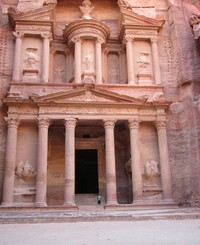Photo. Al-Khazneh, also called the Treasury," in Petra, Jordan - carved directly into the rose-red sandstone cliff. © Travel Explorations.
Around 20 years after my visit to the ancient city of Petra, new secrets are still being uncovered. During my wanderings in Petra, I came over some archaeological excavations. Naturally, my curiosity was piqued. What secrets were they unearthing beneath the layers of history? The city was built by the Nabateans, once a nomadic people, who turned this desert marvel into a hub of culture and history.
Using ground-penetrating radar, a team from the American Center of Research identified this remarkable site beneath the building. In a stunning coincidence, one of the skeletons was holding a ceramic vessel that looked remarkably like the legendary "Holy Grail." It was the kind of find that seemed to be just ripped straight from the script of an Indiana Jones movie - blurring the line between archaeology and adventure. Petra was actually used as a filming location for Steven Spielberg’s 1989 “Indiana Jones and the Last Crusade”. The Treasury hosted one of the most iconic scenes from “the Last Crusade”, when Jones and his father discover the Holy Grail. It’s as if Petra isn’t just a city of ancient wonders - it’s a place where stories, both real and imagined, intertwine.
At the time I was there, I watched archaeologists carefully work, it was clear how much patience and precision goes into uncovering the past. I found myself wondering: were they searching for more tombs, ancient artifacts, or perhaps clues about how the Nabateans transformed this desert valley into a thriving hub of trade and culture? It’s remarkable to think that even after centuries of exploration, so much of Petra remains undiscovered. Those digs reminded me of how much history is still hidden beneath our feet, waiting to be revealed. Each find, no matter how small, contributes to our understanding of this awe-inspiring city and the people who once called it home.
The Holy Grail, the fabled cup from which Jesus Christ is said to have drunk at the Last Supper, has long captured the imaginations of archaeologists and historians alike. Its legendary status was cemented by tales of King Arthur and his knights, who embarked on epic quests to find this elusive relic.
Petra was voted as one of the New Seven Wonders of the World in the 2000s for its unique architecture and the many mysteries that still surround the city. Al-Khazneh, meaning "The Treasury," is one of the most famous and breathtaking structures in Petra, Jordan. Carved directly into the rose-red sandstone cliffs, it is a grand, intricately decorated façade that stands about 40 meters (131 feet) high. Built by the Nabataeans in the 1st century AD, it was originally a tomb for a Nabataean king. Local folklore suggests it was used to hide a pharaoh's treasure, hence the name “The Treasury.” It became globally famous after appearing in Indiana Jones and the Last Crusade (1989) as the resting place of the Holy Grail.
The discovery sheds light on how the Nabateans treated their dead. The presence of skeletons and grave offerings suggests communal or significant burials, providing clues about social hierarchy, rituals, and beliefs about the afterlife. The tomb underscores how much of Petra remains unexplored. It indicated that the possibility of uncovering more hidden chambers, artifacts, and stories that could reshape our understanding of the city. This discovery is not just an archaeological milestone; it’s a reminder that history is dynamic, with layers waiting to be unearthed. Every find deepens our connection to the past, enriching our understanding of humanity's shared story. For Petra, a place already steeped in wonder, it adds yet another chapter to its mystique.
Petra and its surroundings are truly breathtaking - filled with ancient wonders that stretch beyond imagination. Think about that, the ancient city of Petra in Jordan was forgotten and abandoned for centuries. Thanks to new discoveries, we have the chance to learn more city and life there in the past. The discovery is both fascinating and highly significant for understanding history. Today, Al-Khazneh remains one of the most iconic landmarks of Petra, a UNESCO World Heritage Site, and a must-visit for travellers exploring the ancient city.
Stein Morten Lund, January 2025
Additional information
Read more about the ancient city Petra in Jordan on our website.












